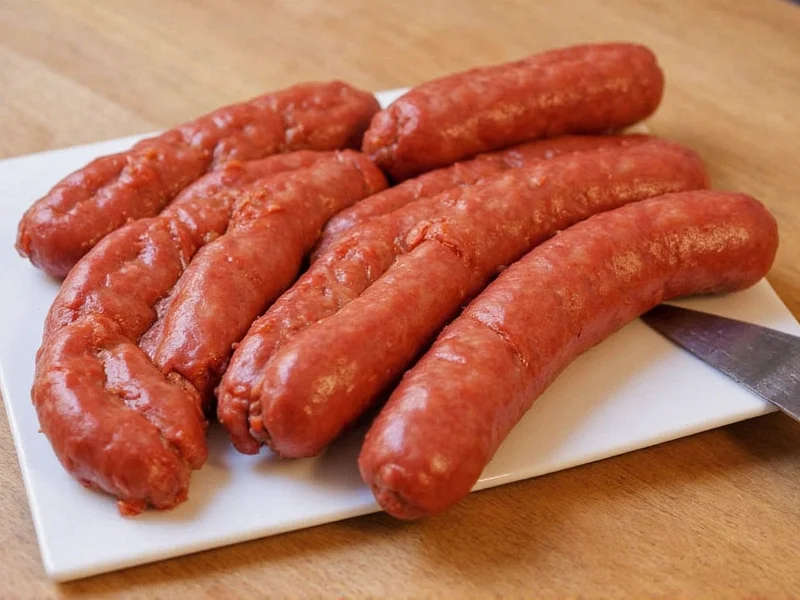Understanding Italian Sausage Preparation
Italian sausage preparation requires attention to detail to achieve the perfect balance of crispy exterior and juicy interior. Whether you're working with sweet or hot varieties, proper technique ensures food safety while maximizing flavor development. This guide covers multiple cooking methods suitable for different kitchen setups and occasions.
Types of Italian Sausage
Before preparing Italian sausage, understand the two primary varieties available:
| Type | Key Characteristics | Best Cooking Method |
|---|---|---|
| Sweet Italian | Mild flavor with fennel and sweet basil | Grilling or pan-searing |
| Hot Italian | Contains red pepper flakes for heat | Simmering then finishing on grill |
| Cured (Salami) | Dry-cured, ready-to-eat | No cooking required |
Essential Preparation Tools
Having the right equipment ensures successful Italian sausage preparation. You'll need:
- Instant-read thermometer (critical for food safety)
- Perforated meat fork or tongs
- Heavy-bottomed skillet for stovetop cooking
- Grill with temperature control
- Baking sheet with rack for oven method
- Aluminum foil for resting cooked sausage
Step-by-Step Cooking Methods
Stovetop Preparation (Best for Weeknight Meals)
The stovetop method delivers consistent results with minimal equipment. Start by placing sausages in a cold skillet with 1 tablespoon of olive oil. Turn heat to medium and cook for 12-15 minutes, rotating every 3-4 minutes. The gradual heating prevents casing rupture while rendering fat evenly. Use your thermometer to verify the internal temperature reaches 160°F (71°C) before removing from heat.
Grilling Technique (Ideal for Outdoor Cooking)
For authentic grilled Italian sausage preparation, preheat your grill to medium (350-400°F). Place sausages perpendicular to grates to prevent rolling. Cook for 15-20 minutes with frequent rotation using tongs. Create a two-zone fire by banking coals to one side, allowing you to move sausages away from flare-ups. The grill marks should form a diamond pattern, indicating proper rotation timing.
Oven Baking Method (Perfect for Large Batches)
When preparing multiple Italian sausages simultaneously, the oven method ensures even cooking. Preheat to 400°F and arrange sausages on a wire rack over a baking sheet. Bake for 20-25 minutes until golden brown and internal temperature reaches 160°F. For extra crispness, broil for the final 2-3 minutes while watching closely to prevent burning.
Food Safety Considerations
Proper food handling is essential when preparing Italian sausage. Always thaw frozen sausage in the refrigerator overnight rather than at room temperature. Never pierce sausages excessively, as this causes juice loss. The USDA recommends cooking pork products to 160°F (71°C) internal temperature, which you should verify with a calibrated thermometer inserted horizontally through the side of the sausage.
Serving Suggestions and Pairings
Traditional Italian sausage preparation often includes specific serving styles. Slice cooked sausage diagonally for sandwiches or serve whole with classic accompaniments like sautéed peppers and onions. For authentic presentation, arrange sausages on a platter with fresh herbs and lemon wedges. Pair with robust red wines like Chianti or Sangiovese, or serve with creamy polenta for a comforting meal.
Storage and Reheating Guidelines
Proper storage extends the enjoyment of your prepared Italian sausage. Refrigerate leftovers within two hours in airtight containers for up to four days. For longer storage, freeze cooked sausage in portion-sized bags for up to three months. When reheating, use the oven at 325°F for best results, as microwaving can make casings tough. Add a splash of water or broth to maintain moisture during reheating.
Common Preparation Mistakes to Avoid
Many home cooks make preventable errors when preparing Italian sausage. Starting with high heat causes casing rupture and uneven cooking. Skipping the resting period results in dry sausage as juices escape immediately upon cutting. Using a fork to turn sausages creates holes that release precious juices. Finally, relying on color alone rather than thermometer readings risks undercooking. Mastering the best way to cook Italian sausage requires patience and attention to temperature.
Frequently Asked Questions
Should I boil Italian sausage before grilling?
Boiling Italian sausage before grilling is unnecessary and can compromise texture. Instead, start sausages on indirect heat to cook through gently, then finish over direct heat for char marks. This traditional Italian sausage preparation method maintains juiciness while achieving proper doneness.
How can I prevent Italian sausage from splitting during cooking?
To prevent splitting when preparing Italian sausage, prick casings gently with a fork in 3-4 places before cooking. Start with lower heat and gradually increase as fat renders. Avoid high initial temperatures which cause rapid steam buildup inside the sausage. Using a thermometer to monitor internal temperature helps prevent overcooking that leads to casing rupture.
What's the difference between cooking fresh and pre-cooked Italian sausage?
Fresh Italian sausage requires thorough cooking to 160°F internal temperature, while pre-cooked varieties only need heating to 140°F. Fresh sausage benefits from slower cooking to render fat properly, whereas pre-cooked sausage can be finished quickly over higher heat for better browning. Always check packaging to determine which type you're preparing.
Can I cook Italian sausage from frozen?
While possible, cooking Italian sausage from frozen isn't recommended for best results. Frozen sausage requires significantly longer cooking time, often resulting in overcooked exteriors before interiors reach safe temperature. For optimal texture and flavor development, thaw sausage in the refrigerator for 24 hours before preparing. If necessary, use the oven method at reduced temperature (325°F) with extended cooking time when working from frozen.











 浙公网安备
33010002000092号
浙公网安备
33010002000092号 浙B2-20120091-4
浙B2-20120091-4